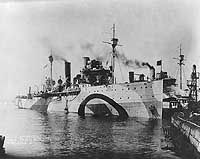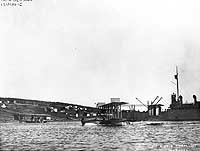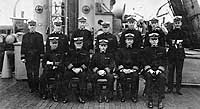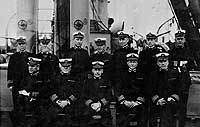
USS Aroostook, a 3,800-ton minelayer, was built in 1907 at Philadelphia, Pennsylvania, as the coastal passenger steamer Bunker Hill. She was acquired by the Navy in November 1917 and renamed within a few days. Placed in commission in December, she was converted to a "mine planter" at the Boston Navy Yard during the next several months. After a brief shakedown cruise, in mid-June 1918 Aroostook took on board a load of mines and began a voyage across the Atlantic Ocean in company with her sister minelayer Shawmut (ID # 1255). The trip, facilitated by the then-novel technique of refueling at sea, took her to Scotland, where in July she began laying thousands of mines in the North Sea to create a deadly barrier for transiting German submarines. This effort came to an end with the 11 November 1918 Armistice, and Aroostook returned home in December.
In the spring of 1919 Aroostook was refitted to support a Navy attempt to fly across the Atlantic. During the first half of May she was at Trepassy Bay, Newfoundland, as base for the three big NC flying boats that departed, eastbound, on the 16th. The ship then steamed to England, where she greeted the NC-4, the only plane to complete the trip by air, at the end of May. Aroostook then took the NC-4 back to U.S. and, in August and early September, carried a cargo of mines and supplies to California. She spent the rest of the year on the West Coast performing transportation duties and on assignment as the Pacific Fleet's aviation flagship.
Though continuing to be classified as a minelayer, and receiving the designation CM-4 in mid-1920, Aroostook's remaining active service was as an aircraft tender. Throughout the 1920s she mainly operated in the eastern Pacific, but made occasional visits to the Caribbean area and the U.S. East Coast to take part in fleet exercises. Aroostook also steamed to Hawaii in 1925 and 1928, on the first occasion as a support ship for a pioneering attempt to fly two patrol planes from the West Coast to Hawaii.
Placed out of commission in March 1931 at the Puget Sound Navy Yard, Bremerton, Washington, Aroostook was laid up for the next decade. With World War II raging in Europe and threatening to spread World-wide, she was considered for reactivation as a cargo ship and, in May 1941, redesignated AK-44. However, her age and limited capabilities kept her inactive. In February 1943, USS Aroostook was stricken from the Navy list and transferred to the War Shipping Administration. Regaining the name Bunker Hill, she stayed in port for the rest of the War. Though sold in 1947 to a firm that planned to use her as a floating casino, these plans fell through and the old ship was seized by the Government, which sold her for scrapping in October 1947.
This page features all the views we have concerning USS Aroostook (ID # 1256, later CM-3 and AK-44) in 1917-1919, and provides links to images taken during her previous commercial career and during her later Navy service.
For other views concerning this ship, see:
| If you want higher resolution reproductions than the digital images presented here, see: "How to Obtain Photographic Reproductions." |
Click on the small photograph to prompt a larger view of the same image.
|
Photo #: NH 57692 USS Aroostook (ID # 1256) At the Boston Navy Yard, Massachusetts, 7 June 1918, following conversion to a mine layer. Her sister ship, USS Shawmut (ID # 1255), is in the background. U.S. Naval Historical Center Photograph. Online Image: 82KB; 740 x 605 pixels |
 |
|
Photo #: NH 57693 USS Aroostook (ID # 1256) Photographed in 1918. Note her pattern camouflage, which was very similar to that of her sister ship, USS Shawmut (ID # 1255). Compare with Photo # NH 42398. U.S. Naval Historical Center Photograph. Online Image: 64KB; 740 x 540 pixels |
 |
|
Photo #: NH 57697 USS Aroostook (ID # 1256) Ship's officers and crew posed on her after deck, while she was at Invergordan, Scotland, in October 1918. Note mats hung on Aroostook's after superstructure for protection against shell splinters. U.S. Naval Historical Center Photograph. Online Image: 104KB; 740 x 530 pixels |
 |
|
Photo #: NH 57696 USS Aroostook (ID # 1256) Ship's officers and crew, photographed on her after deck at Invergordan, Scotland, in October 1918. U.S. Naval Historical Center Photograph. Online Image: 98KB; 740 x 505 pixels |
 |
|
Photo #: NH 95790 Trans-Atlantic Flight of the "NC" Aircraft, May 1919 Captain James H. Tomb, Commanding Officer of USS Aroostook (ID # 1256), shakes hands with Lieutenant Commander Patrick N.L. Bellinger, on board the ship during an early state of the flight. Looking on is Commander Holden C. Richardson. Commander John Towers is walking away at right. U.S. Naval Historical Center Photograph. Online Image: 80KB; 740 x 465 pixels |
 |
The following photographs show USS Aroostook (ID # 1256) distantly, or in the background of views of other subjects:
|
Photo #: 111-SC-43563 Laying the North Sea Mine Barrage, 1918 U.S. Navy minelayers proceeding to sea in two columns, in Area Number 2 of the North Sea, September 1918. Ships in the column at left are (from front to rear): Roanoke, Housatonic, Quinnebaug and Baltimore. Ships in column at right are (from front to rear): Canonicus (out of picture, to right), Canandaigua, Aroostook and Saranac. Note disruptive "dazzle" camouflage worn by these ships. Photograph from the Army Signal Corps Collection in the U.S. National Archives. Online Image: 59KB; 740 x 460 pixels Reproductions of this image may also be available through the National Archives photographic reproduction system. |
 |
|
Photo #: NH 41959 USS Shawmut (ID # 1255) At the Boston Navy Yard, Massachusetts, 4 June 1918, following conversion to a mine layer. Her sister ship, USS Aroostook (ID # 1256), is in the background. These two ships had very similar camouflage schemes. U.S. Naval Historical Center Photograph. Online Image: 101KB; 740 x 615 pixels |
 |
|
Photo #: NH 95777 Seaplane NC-3 Taxies past USS Aroostook (ID # 1256) in Trepassey Bay, Newfoundland, 15 May 1919. NC-1 is moored at left. Aroostook served as the planes' tender during their May 1919 trans-Atlantic flight attempt. U.S. Naval Historical Center Photograph. Online Image: 75KB; 740 x 585 pixels |
 |
The following photograph MAY have been taken from on board USS Aroostook (ID # 1256):
The following photographs show the Commanding Officer of USS Aroostook (ID # 1256):
|
Photo #: NH 52819 Mine Squadron One, U.S. Atlantic Fleet Senior officers of the squadron, photographed on board ship in the North Sea area, September 1918. Those present are identified in Photo # NH 52819 (complete caption). U.S. Naval Historical Center Photograph. Online Image: 96KB; 740 x 430 pixels |
 |
|
Photo #: NH 52995 Mine Squadron One, U.S. Atlantic Fleet Senior officers of the squadron, photographed on board ship in the North Sea area, September 1918. Those present are identified in Photo # NH 52995 (complete caption). U.S. Naval Historical Center Photograph. Online Image: 88KB; 740 x 495 pixels |
 |
For other views concerning this ship, see:
| If you want higher resolution reproductions than the digital images presented here, see: "How to Obtain Photographic Reproductions." |
Page made 9 October 2004